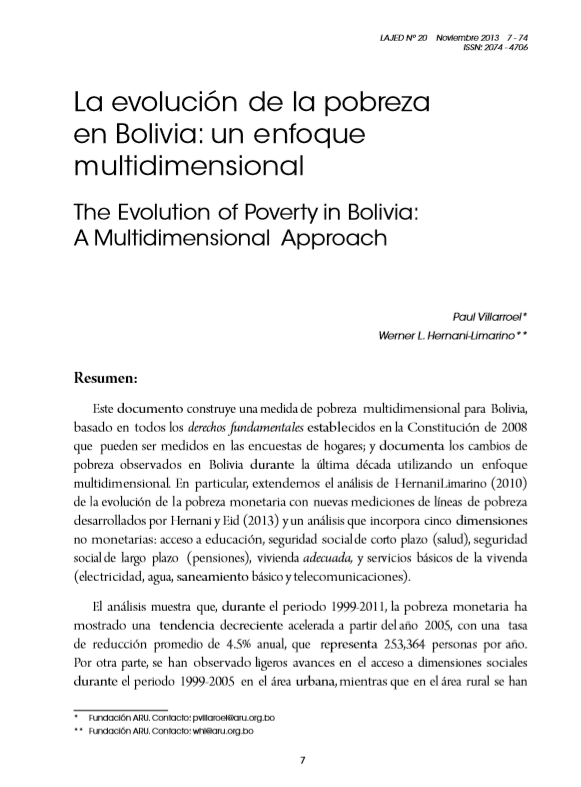The Evolution of Poverty in Bolivia: A Multidimensional Approach
DOI:
https://doi.org/10.35319/lajed.201320101Keywords:
Multidimensional poverty, income poverty, social rights deprivation, unsatisfied basic needs, BoliviaAbstract
This paper constructs a multidimensionalpoverty measurement for Bolivia based on all fundamental rightsestablish in its 2008 Constitution than can be measured in the surveys; and documents the observed poverty changes in Bolivia during the last decade using this multidimensional approach. In particular, we extent Hernani-Limarino (2010) analysis of the evolution of income poverty with an analysis that incorporares five nonincome dimensions: access to education, short term social security (health), long term social security (pensions), adequate dwelling, and basic dwelling services (electricity, water, basic sanitation and telecommunications). Our analysis shows that, during 1999-2011 income poverty has shown a downward trend accelerated from the year 2005 with an average reduction rate of 4.5% per year, representing 253,364 people per year. On the other hand, slight increases were observed in access to social dimensions during 1999-2005 in urban areas, while in rural areas have maintained high levels of deprivation. These results have reduced multidimensional poverty by 24 percentage points during the period from 1999 to 2011 but also an increase of people with social vulnerability due to elusive behavior of non-monetary poverty in the country.
Downloads
References
Alkire S.y Foster, J. (2009). Counting and multidimensional poverty measurement. Oxford Poverty & Human Development Initiative (OPHI), Working Paper Nº 32, revised and updated.
Bourguignon, F. y Chakravarty, S. R. (2003). The measurement of multidimensional poverty. The Journal of Economic Inequality, 1 (1) 25–49
Consejo Nacional de Evaluación de la Política de Desarrollo Social (CONEVAL). (2010) “Metodología para la medición multidimensional de la pobreza en México”
Estado de Bolivia (2008). “Constitución Política del Estado”. La Paz, Bolivia.
Gobierno de Bolivia (1994). “Ley 1565 de reforma educativa”.
---------- (1996). “Ley 1732 de pensiones”.
---------- (1998). “D.S. 25265, seguro básico de salud”.
---------- (1998). “Ley de propiedad y crédito popular”.
---------- (2002). “Ley 2426 del seguro universal materno infantil SUMI”.
---------- (2006). “Plan nacional de desarrollo: Bolivia digna, soberana, productiva y democrática para vivir bien”.
---------- (2007). “Ley de la renta universal de vejez”.
---------- (2010). “Ley 070 de educación Avelino Siñani-Elizardo Pérez”.
Hernani-Limarino, W. (2009). Una evaluación crítica de las medidas oficiales de pobreza en Bolivia.
---------- (2010). Poor Poverty Measurement: Unraveling Poverty Changes in Bolivia.
Hernani-Limarino, W. y Eid, A. (2013). “Unraveling Declining Income Inequality in Bolivia: Do Government Transfers Matter?” Paper Prepared for the IARIW-IBGE Conference on Income, Wealth and Well-Being in Latin America.
Instituto Nacional de Estadística (2002). “Metodología para el cálculo de necesidades básicas insatisfechas (NBI)”. La Paz, Bolivia.






